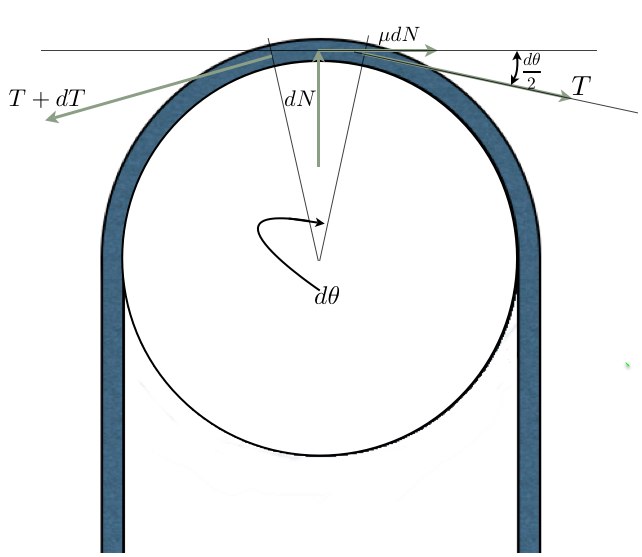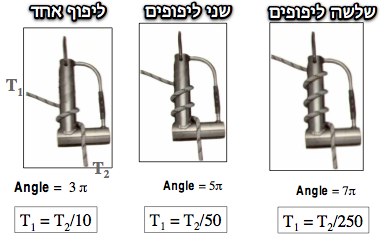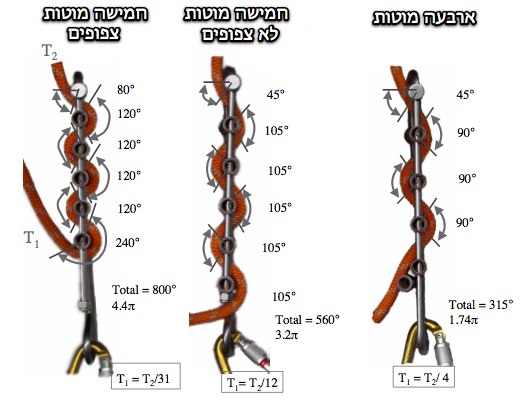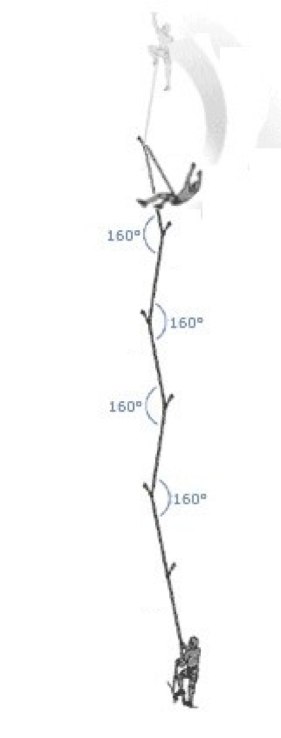?How do friction devices work
The basic principle for most friction devices can be demonstrated by a rope wrapped around a capstan. The whole purpose of a friction device is to make the rope push into the surface of the device, thus generating friction. The more friction, the easier it is for the belayer to hold the rope and arrest a fall. The way to do that is to supply friction around something: a capstan, a carabiner, a pole, a belay device.
The same principle applies along a rope dragged over rock.
תוכן עניינים
A reminder about friction and a simple calculation
A short reminder: friction is a force, and it can be calculated as: עיבוד הנוסחה נכשל (קובץ ההפעלה <code>texvc</code> אינו זמין. נא לעיין ב־math/README כדי להגדירו.): F_f=\mu F_N . Where: עיבוד הנוסחה נכשל (קובץ ההפעלה <code>texvc</code> אינו זמין. נא לעיין ב־math/README כדי להגדירו.): \mu is called the friction coefficient and is a trait of the two materials touching and being dragged against each other, and עיבוד הנוסחה נכשל (קובץ ההפעלה <code>texvc</code> אינו זמין. נא לעיין ב־math/README כדי להגדירו.): F_N , the Normal force, is the force that's perpendicular to the surface of contact between the two bodies.
In order to understand the rest, there no real need to follow all the mathematical-physical stuff. If you feel you're mathematically challenged, you can just take the final formula and skip directly to the examples section.
Let us consider the friction for a length element of a rope over a capstan.
When a short piece of rope is passing on a capstan, the friction for that length element can be easily calculated by using the basic definition of friction force. We assume that the piece of rope is so short, that it's approximately straight. The illustration describes the forces on that piece of rope:
The normal force עיבוד הנוסחה נכשל (קובץ ההפעלה <code>texvc</code> אינו זמין. נא לעיין ב־math/README כדי להגדירו.): F_N , can be calculated be summing the two components of the rope tension to the עיבוד הנוסחה נכשל (קובץ ההפעלה <code>texvc</code> אינו זמין. נא לעיין ב־math/README כדי להגדירו.): T directed towards the center of the capstan. We call this component עיבוד הנוסחה נכשל (קובץ ההפעלה <code>texvc</code> אינו זמין. נא לעיין ב־math/README כדי להגדירו.): T_y , and it is equal to:
עיבוד הנוסחה נכשל (קובץ ההפעלה <code>texvc</code> אינו זמין. נא לעיין ב־math/README כדי להגדירו.): T_y=\mu T\sin\frac{\alpha}{2}
Therefore, the friction force is:
עיבוד הנוסחה נכשל (קובץ ההפעלה <code>texvc</code> אינו זמין. נא לעיין ב־math/README כדי להגדירו.): F_f=\mu F_N=2 \mu T_y\,\!
or, substituting עיבוד הנוסחה נכשל (קובץ ההפעלה <code>texvc</code> אינו זמין. נא לעיין ב־math/README כדי להגדירו.): F_N :
עיבוד הנוסחה נכשל (קובץ ההפעלה <code>texvc</code> אינו זמין. נא לעיין ב־math/README כדי להגדירו.): F_f=2\mu T \sin\frac{\alpha}{2}
The friction force works against the sliding of the rope on the capstan, and in fact, the tensions on both sides of the capstan are not the same. The following illustration is more realistic:
The Tension on the rope tied to the load is the load itself. We call that עיבוד הנוסחה נכשל (קובץ ההפעלה <code>texvc</code> אינו זמין. נא לעיין ב־math/README כדי להגדירו.): T_2 and we can write: therefore:
עיבוד הנוסחה נכשל (קובץ ההפעלה <code>texvc</code> אינו זמין. נא לעיין ב־math/README כדי להגדירו.): T_2=w .
The tension on the other side of the capstan is smaller, and is called here simply עיבוד הנוסחה נכשל (קובץ ההפעלה <code>texvc</code> אינו זמין. נא לעיין ב־math/README כדי להגדירו.): T_1 .
The friction force, עיבוד הנוסחה נכשל (קובץ ההפעלה <code>texvc</code> אינו זמין. נא לעיין ב־math/README כדי להגדירו.): F_f , is proportional to the normal force, עיבוד הנוסחה נכשל (קובץ ההפעלה <code>texvc</code> אינו זמין. נא לעיין ב־math/README כדי להגדירו.): F_N , which we've already found.
A little more complicated calculation.
When we have a longer section of rope around a capstan, the tension changes with every length element rubbing against the capstan. The change in tension עיבוד הנוסחה נכשל (קובץ ההפעלה <code>texvc</code> אינו זמין. נא לעיין ב־math/README כדי להגדירו.): dT , actually happens with every change in angle, which we call עיבוד הנוסחה נכשל (קובץ ההפעלה <code>texvc</code> אינו זמין. נא לעיין ב־math/README כדי להגדירו.): d\alpha . We can call the normal force for every rope element עיבוד הנוסחה נכשל (קובץ ההפעלה <code>texvc</code> אינו זמין. נא לעיין ב־math/README כדי להגדירו.): dN . The total friction is a summation (or integration) of the changes in tension over all the rope elements touching the capstan.
In a constant, steady state, the sum of forces vanishes, that is also specifically true for the forces in the עיבוד הנוסחה נכשל (קובץ ההפעלה <code>texvc</code> אינו זמין. נא לעיין ב־math/README כדי להגדירו.): x direction.
עיבוד הנוסחה נכשל (קובץ ההפעלה <code>texvc</code> אינו זמין. נא לעיין ב־math/README כדי להגדירו.): \Sigma F_x=0\,\!
עיבוד הנוסחה נכשל (קובץ ההפעלה <code>texvc</code> אינו זמין. נא לעיין ב־math/README כדי להגדירו.): T\cos\frac{d\theta}{2}+\mu(dN)-(T+dT)\cos\frac{d\theta}{2}=0
since עיבוד הנוסחה נכשל (קובץ ההפעלה <code>texvc</code> אינו זמין. נא לעיין ב־math/README כדי להגדירו.): d\theta is very small, and its cosine is very close to one, the expression can be reduced to:
עיבוד הנוסחה נכשל (קובץ ההפעלה <code>texvc</code> אינו זמין. נא לעיין ב־math/README כדי להגדירו.): \mu(dN)=dT\,\!
Similarly, the forces in the עיבוד הנוסחה נכשל (קובץ ההפעלה <code>texvc</code> אינו זמין. נא לעיין ב־math/README כדי להגדירו.): y direction cancel each other and from the constraint עיבוד הנוסחה נכשל (קובץ ההפעלה <code>texvc</code> אינו זמין. נא לעיין ב־math/README כדי להגדירו.): \Sigma F_y=0\,\! , we get:
עיבוד הנוסחה נכשל (קובץ ההפעלה <code>texvc</code> אינו זמין. נא לעיין ב־math/README כדי להגדירו.): dN-(T+dT)\sin\frac{d\theta}{2}-T\sin\frac{d\theta}{2}=0
עיבוד הנוסחה נכשל (קובץ ההפעלה <code>texvc</code> אינו זמין. נא לעיין ב־math/README כדי להגדירו.): dN=2T\sin\frac{d\theta}{2}+dT\sin\frac{d\theta}{2}=0
Since a sine of a small number equals that number itself:
עיבוד הנוסחה נכשל (קובץ ההפעלה <code>texvc</code> אינו זמין. נא לעיין ב־math/README כדי להגדירו.): dN=2T\frac{d\theta}{2}+\frac{dT d\theta}{2}=0
We can ignore the product of two very small expressions and thus:
עיבוד הנוסחה נכשל (קובץ ההפעלה <code>texvc</code> אינו זמין. נא לעיין ב־math/README כדי להגדירו.): dN=Td\theta\,\!
If we substitute עיבוד הנוסחה נכשל (קובץ ההפעלה <code>texvc</code> אינו זמין. נא לעיין ב־math/README כדי להגדירו.): dN , we have an expression that is independent of the normal forces, and is a differential equation that describes עיבוד הנוסחה נכשל (קובץ ההפעלה <code>texvc</code> אינו זמין. נא לעיין ב־math/README כדי להגדירו.): T :
עיבוד הנוסחה נכשל (קובץ ההפעלה <code>texvc</code> אינו זמין. נא לעיין ב־math/README כדי להגדירו.): \frac{dT}{T}=\mu d\theta\,\!
In order to find the difference in rope tension on both sides of the capstan we need to integrate the differences on the total angle in which the rope comes in contact with the capstan:
עיבוד הנוסחה נכשל (קובץ ההפעלה <code>texvc</code> אינו זמין. נא לעיין ב־math/README כדי להגדירו.): \int_{T_1}^{T_2}\frac{dT}{T} = \int_0^\alpha \mu d\theta
After the integration we get:
עיבוד הנוסחה נכשל (קובץ ההפעלה <code>texvc</code> אינו זמין. נא לעיין ב־math/README כדי להגדירו.): \ln\frac{T_1}{T_2} = \mu\alpha
The force we need to pull the rope, עיבוד הנוסחה נכשל (קובץ ההפעלה <code>texvc</code> אינו זמין. נא לעיין ב־math/README כדי להגדירו.): T_1 is:
עיבוד הנוסחה נכשל (קובץ ההפעלה <code>texvc</code> אינו זמין. נא לעיין ב־math/README כדי להגדירו.): T_1=T_2e^{\mu\alpha}\,\!
And the friction force is the difference between the tensions on the opposite sides of the capstan:
עיבוד הנוסחה נכשל (קובץ ההפעלה <code>texvc</code> אינו זמין. נא לעיין ב־math/README כדי להגדירו.): F_f=T_2(1-e^{\mu\alpha})\,\!
As a matter of fact, with a capstan with a larger diameter than a critical diameter, the friction is independent of the length of rope wrapped (and so independent of the diameter of the capstan) and is only dependent on the total angle of contact.
Half way through summary
We calculated that the friction of a rope on a capstan is determined by three factors:
- Rope tension.
- The friction coefficient.
- The total angle of contact between the rope and capstan.
The friction is directly proportional to the tension, and exponentially rises with the contact angle and the friction coefficient. If we assume that the friction coefficient is constant, for example, NyLon rope with a typical Aluminum alloy (like A7075, frequently used for climbing gear), we can compare between different devices.
It is important to remember, that the coefficient of friction depends strongly on rope characteristics and condition. For a new rope, the friction coefficient is low, and even more so for wet and muddy ropes. For old, worn and "wooly" ropes, the friction coefficient can be significantly higher.
And one more remark about the total contact angle, or the fraction of a wrap, that the rope does around the capstan. This is, in fact, true for capstans larger than a certain critical diameter. That is, however, a pretty good approximation for "soft" ropes only, for capstans that have larger diameter than the rope (i.e. [[Figure of eight, biners, and other friction devices).
It is different with ATC, Reverso and other belay plates, where the rope goes over thinner edges, which simulate a smaller diameter capstan. In these cases the calculation will be different. The rope is then shapes like an up-side down U. There is a very short section of rope that is pressed onto the device, and on both sides, it almost doesn't touch. If we assume that the rope is rigid enough, the normal force on the short segment that is pressed to the device is approximately twice the tension and the friction is very high.
עניין אחרון, הזווית עיבוד הנוסחה נכשל (קובץ ההפעלה <code>texvc</code> אינו זמין. נא לעיין ב־math/README כדי להגדירו.): \alpha במשוואה, היא ביחידות של רדיאנים. אם רוצים להציב ערכים ולקבל תוצאה מספרית, אלו היחידות בהן צריך להשתמש.
נזכיר כי רדיאן אחד הוא הזווית בה אורך הקשת שווה לרדיוס. מכיוון שהיחס בין הרדיוס להיקף הוא עיבוד הנוסחה נכשל (קובץ ההפעלה <code>texvc</code> אינו זמין. נא לעיין ב־math/README כדי להגדירו.): 2\pi , הרי שזווית המגע על פני סיבוב שלם, 360°, היא עיבוד הנוסחה נכשל (קובץ ההפעלה <code>texvc</code> אינו זמין. נא לעיין ב־math/README כדי להגדירו.): 2\pi רדיאנים, או 6.28 רדיאנים, בערך. רדיאן אחד שווה בערך ל-57.29°.
דוגמאות
example 1: מוט עגול, צינור או טיובה
הimage מסבירה את עצמה הכי טוב, כנראה. ניתן לראות את הזווית גדלה, ואיתה החיכוך. היחס המספרי בין המתיחויות לפני ואחרי אמצעי החיכוך חושבו עם מקדם חיכוך של עיבוד הנוסחה נכשל (קובץ ההפעלה <code>texvc</code> אינו זמין. נא לעיין ב־math/README כדי להגדירו.): \mu = 0.25 .
כל ליפוף נוסף של החבל על הצינור של הטיובה מוסיף 540° או עיבוד הנוסחה נכשל (קובץ ההפעלה <code>texvc</code> אינו זמין. נא לעיין ב־math/README כדי להגדירו.): 2\pi .
example 2: סולם
בסולם יש שתי אפשרויות עיקריות להגדיל את החיכוך.
האפשרות הראשונה, על ידי הוספת שלבים לסולם. בצורה זו גדלה זווית המגע בין החבל למוטות של הסולם.
האפשרות השניה מגדילה את הזווית על ידי קירובם של השלבים זה לזה. ציפוף של השלבים מכריח את החבל להתלפף יותר סביב המוטות ושוב, זוית המגע גדלה.
example 3: שמינית
אם בוחנים את מעבר החבל בשמינית מגלים שבמצב בו יש מינימום חיכוך, שבו "קל" לתת חבל, יש זווית מגע של 540° (180°+180°+180°), או עיבוד הנוסחה נכשל (קובץ ההפעלה <code>texvc</code> אינו זמין. נא לעיין ב־math/README כדי להגדירו.): 3\pi .
במצב "נעול", כלומר עם חיכוך מקסימאלי, במקום 180°, ביציאה מהשמינית, יש 270°, ובסך הכל 630° או עיבוד הנוסחה נכשל (קובץ ההפעלה <code>texvc</code> אינו זמין. נא לעיין ב־math/README כדי להגדירו.): 3.5\pi .
בשמינית, אם כן, בין המצבים של מינימום ומקסימום חיכוך על פי משוואת התוף, יש הבדל של 16.66% בלבד. ידוע כי בשמינית קשה לקחת ולתת חבל במהירות גם במצב של חיכוך מינימאלי. מאידך, ההבדל הקטן יחסית ביו שני המצבים הופל את השמינית אמצעי טוב לגלישה: גם במצב "פתוח" אין זרימה מאד מהירה של חבל, וקל לווסת את כמות החיכוך ביניהם.
המעבר בין שני המצבים הוא כמעט רציף.
example 4: שטיכט
למרבית אמצעי החיכוך שמבוססים על מבנה של שטיכט יש איזור "שבירה" של החבל בו ה"מוט" עליו עובר החבל במצב נעילה הוא דק בהרבה מאורך החבל.
אם בוחנים את מעבר החבל באמצעי חיכוך כזה, מגלים שבמצב בו יש מינימום חיכוך, יש זווית מגע של 180° בלבד, רק על הטבעת, או זווית של עיבוד הנוסחה נכשל (קובץ ההפעלה <code>texvc</code> אינו זמין. נא לעיין ב־math/README כדי להגדירו.): \frac{\pi}{2} רדיאנים. באמצעי חיכוך כאלה קל מאד לקחת ולתת חבל במצב "פתוח", הרבה יותר משמינית.
בimage מוצגים שני אמצעי חיכוך מקבוצה זו: שטיכט וטיובר.
במצב של "נעילה", החישוב שלנו, כאמור, אינו מהווה קירוב טוב ויש השפעה חזקה לרדיוס העקמומיות של שפת אמצעי החיכוך, ושל הנוטביליטי של החבל.
example 5: אמצעים ננעלים אוטומטית
הכוונה היא לאמצעי חיכוך מורכבים, לחבל יחיד כמו גריגרי, סטופ, ID, אבל גם פשוטים כמו (טוקאן, רברסו, גלובוס וגיגי במצב אוטולוק). במצב פתוח, באמצעים אלה, החלקת החבל היא איטית וניתן להעריך את החיכוך על פי העקרונות שהוסברו למעלה, כלומר, לפי זווית המגע של החבל עם התוף. נסו להשוות בין גיגי לגריגרי, במצב פתוח, בתור תרגיל.
במצב נעילה, לעומת זאת, המצב שונה. כאן התיאוריה קורסת לחלוטין. באמצעים אלה הנעילה מתבצעת על ידי הגדלה משמעותית של כוח החיכוך בקטע חבל אחד, על ידי לחיצה או צביטה חזקה של החבל. לכן, במצב נעילה אין משמעות לזווית המגע, אלא להמרה של החיכוך בזרימת החבל ללחיצה בניצב לכיוון ההחלקה. אבל זה נושא למאמר אחר...
example 6: חיכוך בנפילת הובלה
החיכוך הנוצר ממעבר החבל בטבעות בזמן נפילה בהובלה גורם לכך שעל קטעי חבל שונים יש מתיחות שונה. ניתן להעריך את ההפרש בין הכוח שמרגיש המטפס (כוח הבלימה) לבין הכוח שמרגיש המאבטח. הפרש זה יהיה כוח החיכוך המתפתח בכל הטבעות של כל הראנרים יחד. את הכוח הזה ניתן לחשב על ידי חיבור הזויות של החבל בכל העגינות והצבת הזווית הכללית בנוסחה.
מכאן ברור שאם הזוית בעגינה מסויימת חדה, לא רק שלמוביל יהיה דראג (חיכוך על הסלע ובטבעות), אלא גם שבמקרה של נפילה, זוית חדה בעצם "מפרידה" בין שני קטעי חבל. מקבלים שבמקום מקדם נפילה שרגילים לקחת כהערכה לכוח הבלימה, במקרה כזה יש ומקדם הנפילה האפקטיבי שהוא גדול יותר מזה התיאורטי.
קישורים חיצוניים
- המאמר העיקרי עליו מתבסס מאמר זה
- עוד מאמר אחד, גם על חיכוך בסוגי סלעים שונים
- במאמר הזה יש ניתוח של כוחות באמצעי חיכוך, בכל מיני מצבים: טיפוס, גלישה, חילוץ.
Contributions to this page were made by Mica Yaniv and others...








